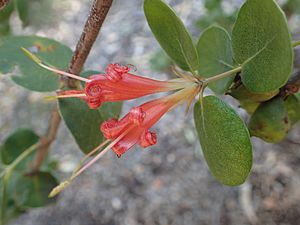Roundleaf honeysuckle facts for kids
Quick facts for kids Roundleaf honeysuckle |
|
|---|---|
 |
|
| Lambertia orbifolia in Kings Park, Perth | |
| Conservation status | |
| Scientific classification | |
| Genus: |
Lambertia
|
| Species: |
orbifolia
|
The Lambertia orbifolia, also known as the roundleaf honeysuckle, is a special kind of shrub or small tree. It only grows in the south-west part of Western Australia. This plant has round leaves and pretty orange-red flowers that grow in small groups.
Contents
What it Looks Like
The roundleaf honeysuckle is a shrub or small tree that can grow up to 5 meters (about 16 feet) tall. It has branches that stand up and spread out, and they are covered with soft hairs. Its leaves are usually arranged in pairs, but sometimes they grow in groups of three around the stem. Each leaf is about 15 to 20 millimeters (about 0.6 to 0.8 inches) wide and is attached directly to the stem without a stalk.
The flowers grow in groups of four to six. Each flower is about 40 to 60 millimeters (about 1.6 to 2.4 inches) long. They are orange-red and shaped like a tube, with tiny hairs inside. At the bottom of the flowers, there are overlapping leaf-like parts called bracts. You can see these flowers almost all year, but they are most common between November and May. After the flowers, the plant produces a woody fruit that is like a small, dry seed pod, about 7 to 10 millimeters (about 0.3 to 0.4 inches) wide, with a short pointed tip.
How it Got its Name
The Lambertia orbifolia was first officially described in 1964 by a botanist named Charles Gardner. He studied a plant sample collected near the Scott River in 1945. His description was published in a science journal called the Journal of the Royal Society of Western Australia.
The plant's scientific name, orbifolia, comes from two Latin words: orbis, which means "anything circular," and -folius, which means "leaved." So, orbifolia simply means "round-leaved," which perfectly describes its unique leaves!
Scientists have also identified two types of this plant, called subspecies, but they haven't been officially named yet.
Where it Lives
The roundleaf honeysuckle is found in two main areas, which match the two different subspecies. One type grows near Narrikup, where it lives among jarrah and marri trees in a type of forest called banksia woodland. The other type grows in thick shrubland and heathland areas on the Scott River Plains.
Plant Life and Challenges
When there's a fire, the roundleaf honeysuckle plants usually die. However, new plants can grow from seeds very soon after a fire. Not many new seeds sprout between fires. This plant can also get sick from a plant disease called Phytophthora cinnamomi, which is caused by a type of water mold.
The main animal that helps pollinate this plant (meaning it helps the plant make seeds) is thought to be the New Holland honeyeater, a type of bird.
Protecting the Plant
Both types of the roundleaf honeysuckle are considered "Threatened Flora" by the government in Western Australia. This means they are very rare and need protection. They are also listed as "critically endangered" under a special law called the Biodiversity Conservation Act 2016.
A plan has been made to help save one of the subspecies. This type is in danger of disappearing because of the Phytophthora cinnamomi disease and also from damage caused by road work. There's even a plan to move some of these plants to new, safer locations. The Australian government also lists the species as "endangered" under the Environment Protection and Biodiversity Conservation Act 1999. The biggest dangers to the roundleaf honeysuckle are the plant disease, damage from road and track maintenance, and changes in how water flows in its habitat.
Images for kids



